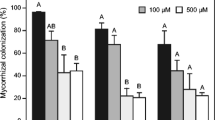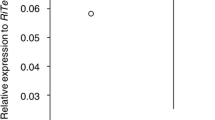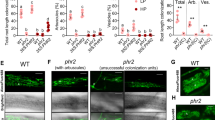Abstract
The development of mutualistic interactions with arbuscular mycorrhizal (AM) fungi is one of the most important adaptation of terrestrial plants to face mineral nutrition requirements. As an essential plant nutrient, phosphorus uptake is acknowledged as a major benefit of the AM symbiosis, but the molecular mechanisms of its transport as inorganic phosphate (Pi) from the soil to root cells via AM fungi remain poorly known. Here we monitored the expression profile of the high-affinity phosphate transporter (PT) gene (GintPT) of Rhizophagus irregularis (DAOM 197198) in fungal structures (spores, extraradical mycelium and arbuscules), under different Pi availability, and in respect to plant connection. GintPT resulted constitutively expressed along the major steps of the fungal life cycle and the connection with the host plant was crucial to warrant GintPT high expression levels in the extraradical mycelium. The influence of Pi availability on gene expression of the fungal GintPT and the Medicago truncatula symbiosis-specific Pi transporter (MtPT4) was examined by qRT-PCR assay on microdissected arbusculated cells. The expression profiles of both genes revealed that these transporters are sensitive to changing Pi conditions: we observed that MtPT4 mRNA abundance is higher at 320 than at 32 μM suggesting that the flow towards the plant requires high concentrations. Taken on the whole, the findings highlight novel traits for the functioning of the GintPT gene and offer a molecular scenario to the models describing nutrient transfers as a cooperation between the mycorrhizal partners.





Similar content being viewed by others
Abbreviations
- AM:
-
Arbuscular mycorrhizal
- ARB:
-
Arbuscule-containing cells
- Ct:
-
Threshold cycle
- ERM:
-
Extraradical mycelium
- IRM:
-
Intraradical mycelium
- LMD:
-
Laser microdissection
- P:
-
Phosphorus
- Pi:
-
Inorganic orthophosphate
- PT:
-
Phosphate transporter
- ROCs:
-
Root organ cultures
References
Allen JW, Shachar-Hill Y (2009) Sulfur transfer through an arbuscular mycorrhiza. Plant Physiol 149:549–560
Balestrini R, Gomez-Ariza J, Lanfranco L, Bonfante P (2007) Laser microdissection reveals that transcripts for five plant and one fungal phosphate transporter genes are contemporaneously present in arbusculated cells. Mol Plant Microbe Interact 20:1055–1062
Balzergue C, Puech-Pages V, Bécard G, Rochange SF (2011) The regulation of arbuscular mycorrhizal symbiosis by phosphate in pea involves early and systemic signaling events. J Exp Bot 62:1049–1060
Bécard G, Fortin JA (1988) Early events of vesicular arbuscular mycorrhizal formation on Ri T-DNA transformed roots. New Phytol 108:211–218
Benedetto A, Magurno F, Bonfante P, Lanfranco L (2005) Expression profiles of a phosphate transporter gene (GmosPT) from the endomycorrhizal fungus Glomus mosseae. Mycorrhiza 15:620–627
Bieleski RL (1973) Phosphate pools, phosphate transport, and phosphate availability. Annu Rev Plant Physiol 24:225–252
Boivin JR, Salifu KF, Timmer VR (2004) Late-season fertilization of Picea mariana seedlings: intensive loading and outplanting response on greenhouse bioassays. Ann For Sci 61:737–745
Bonfante P, Genre A (2010) Mechanisms underlying beneficial plant–fungus interactions in mycorrhizal symbiosis. Nat Commun 1:1–11
Breuillin F, Schramm J, Hajirezaei M et al (2010) Phosphate systemically inhibits development of arbuscular mycorrhiza in Petunia hybrida and represses genes involved in mycorrhizal functioning. Plant J 64:1002–1017
Bücking H, Shachar-Hill Y (2005) Phosphate uptake, transport and transfer by the arbuscular mycorrhizal fungus Glomus intraradices is stimulated by increased carbohydrate availability. New Phytol 165:899–911
Bun-ya M, Nishimura M, Harashima S, Oshima Y (1991) The PHO84 gene of Saccharomyces cerevisiae encodes an inorganic phosphate transporter. Mol Cell Biol 11:3229–3238
Callow JA, Capaccio LCM, Parish G, Tinker PB (1978) Detection and estimation of polyphosphate in vesicular–arbuscular mycorrhizas. New Phytol 80:125–134
Doener P (2008) Phosphate starvation signaling: a threesome controls systemic Pi homeostasis. Curr Opin Plant Biol 11:536–540
Ezawa T, Smith SE, Smith FA (2001) Differentiation of polyphosphate metabolism between the extra- and intraradical hyphae of arbuscular mycorrhizal fungi. New Phytol 149:555–563
Ezawa T, Cavagnaro TR, Smith SE, Smith FA, Ohtomo R (2003) Rapid accumulation of polyphosphate in extraradical hyphae of an arbuscular mycorrhizal fungus as revealed by histochemistry and a polyphosphate kinase/luciferase system. New Phytol 161:387–392
Fellbaum CR, Gachomo EW, Beesetty Y, Choudhari S, Strahan GD, Pfeffer PE, Kiers ET, Bücking H (2012) Carbon availability triggers fungal nitrogen uptake and transport in arbuscular mycorrhizal symbiosis. Proc Natl Acad Sci USA 109:2666–2671
Gomez-Ariza J, Balestrini R, Novero M, Bonfante P (2009) Cell-specific gene expression of phosphate transporters in mycorrhizal tomato roots. Biol Fertil Soils 45:845–853
Gonzàlez-Guerrero M, Oger E, Benabdellah K, Azcόn-Aguilar C, Lanfranco L, Ferrol N (2010) Characterization of a CuZn superoxide dismutase gene in the arbuscular mycorrhizal fungus Glomus intraradices. Curr Genet 56:265–274
Guether M, Balestrini R, Hannah MA, Udvardi MK, Bonfante P (2009) Genome-wide reprogramming of regulatory networks, transport, cell wall and membrane biogenesis during arbuscular mycorrhizal symbiosis in Lotus japonicus. New Phytol 182:200–212
Hammer EC, Pallon J, Wallander H, Olsson PA (2011) Tit for tat? A mycorrhizal fungus accumulates phosphorus under low plant carbon availability. FEMS Microbiol Ecol 76:236–244
Harrison MJ, Van Buuren ML (1995) A phosphate transporter from the mycorrhizal fungus Glomus versiforme. Nature 378:626–629
Harrison MJ, Dewbre GR, Liu J (2002) A phosphate transporter from Medicago truncatula involved in the acquisition of phosphate released by arbuscular mycorrhizal fungi. Plant Cell 14:2413–2429
Helber N, Wippel N, Schaarschmidt S, Hause B, Requena N (2011) A versatile monosaccharide transporter that operates in the arbuscular mycorrhizal fungus Glomus species. is crucial for the symbiotic relationship with plants. Plant Cell 23:3812–3823
Hewitt EJ (1966) Sand and water culture methods used in the study of plant nutrition. Commonwealth Agricultural Bureaux, Farnham Royal
Hijikata N, Murase M, Tani C, Ohtomo R, Osaki M, Ezawa T (2010) Polyphosphate has a central role in the rapid and massive accumulation of phosphorus in extraradical mycelium of an arbuscular mycorrhizal fungus. New Phytol 186:285–289
Hohnjec N, Vieweg ME, Pühler A, Becker A, Küster H (2005) Overlaps in the transcriptional profiles of Medicago truncatula roots inoculated with two different Glomus fungi provide insights into the genetic program activated during arbuscular mycorrhiza. Plant Physiol 137:1283–1301
Humphreys CP, Franks PJ, Rees M, Bidartondo MI, Leake JR, Beerling DJ (2010) Mutualistic mycorrhiza-like symbiosis in the most ancient group of land plants. Nat Commun 1:103
Javot H, Pumplin N, Harrison MJ (2007) Phosphate in the arbuscular mycorrhizal symbiosis: transport properties and regulatory roles. Plant Cell Environ 30:310–322
Kiers ET, Duhamel M, Beesetty Y, Mensah JA, Franken O, Verbruggen E, Fellbaum CR, Kowalchuk GA, Hart MM, Bago A, Palmer TM, West SA, Vandenkoornhuyse P, Jansa J, Bücking H (2011) Reciprocal rewards stabilize cooperation in the mycorrhizal symbiosis. Science 333:880–882
Krüger M, Krüger C, Walker C, Stockinger H, Schüßler A (2012) Phylogenetic reference data for systematics and phylotaxonomy of arbuscular mycorrhizal fungi from phylum to species level. New Phytol 193:970–984
Lambers H, Finnegan PM, Laliberté E, Pearse SJ, Ryan MH, Shane MW, Veneklaas EJ (2011) Phosphorus nutrition of Proteaceae in severely phosphorus-impoverished soils: are there lessons to be learned for future crops? Plant Physiol 156:1058–1066
Laparre J, Balzergue C, Rochange S, Ludwiczak P, Letisse F, Portais JC, Bécard G, Puech-Pages V (2011) Metabolite profiling of pea roots in response to phosphate availability. Plant Signal Behav 6:837–839
Lawrence D (2001) Nitrogen and phosphorus enhance growth and luxury consumption of four secondary forest tree species in Borneo. J Trop Ecol 17:859–869
Maldonado-Mendoza IE, Dewbre GR, Harrison MJ (2001) A phosphate transporter gene from the extra-radical mycelium of an arbuscular mycorrhizal fungus Glomus intraradices is regulated in response to phosphate in the environment. Mol Plant Microbe Interact 14:1140–1148
Marschner H (1995) Mineral nutrition of higher plants. Academic Press Inc, London
Nagy R, Drissner D, Amrhein N, Jakobsen I, Bucher M (2009) Mycorrhizal phosphate uptake pathway in tomato is phosphorus-repressible and transcriptionally regulated. New Phytol 181:950–959
Oger E, Ghignone S, Campagnac E, Fontaine J, Grandmougin-Ferjani A, Lanfranco L (2009) Functional characterization of a C-4 sterol methyl oxidase from the endomycorrhizal fungus Glomus intraradices. Fungal Genet Biol 46:486–495
Parniske M (2008) Arbuscular mycorrhiza: the mother of plant root endosymbioses. Nat Rev Microbiol 6:763–775
Pearson JN, Jakobsen I (1993) Uptake by arbuscular mycorrhizal plants, measured by dual labelling with P-32 and P-33. The relative contribution of hyphae and roots to phosphorus. New Phytol 124:489–494
Péret B, Clément M, Nussaume L, Desnos T (2011) Root developmental adaptation to phosphate starvation: better safe than sorry. Trend Plant Sci 16:442–450
Pérez Torres CA, López Bucio J, Herrera Estrella L (2009) Low phosphate signaling induces changes in cell cycle gene expression by increasing auxin sensitivity in the Arabidopsis root system. Plant Signal Behav 4:781–783
Pérez-Tienda J, Testillano PS, Balestrini R, Fiorilli V, Azcón-Aguilar C, Ferrol N (2011) GintAMT2, a new member of the ammonium transporter family in the arbuscular mycorrhizal fungus Glomus intraradices. Fungal Genet Biol 48:1044–1055
Ravnskov S, Jakobsen I (1995) Functional compatibility in arbuscular mycorrhizas measured as hyphal P transport to the plant. New Phytol 129:611–618
Ririe KM, Rasmussen RP, Wittwer CT (1997) Product differentiation by analysis of DNA melting curves during the polymerase chain reaction. Anal Biochem 245:154–160
Selosse FA, Rousset M (2011) The plant-fungal marketplace. Science 333:828–829
Sharda JN, Koide RT (2010) Exploring the role of root anatomy in P-mediated control of colonization by arbuscular mycorrhizal fungi. Botany 88:165–173
Sharma NC, Sahi SV (2005) Characterization of phosphate accumulation in Lolium multiflorum for remediation of phosphorus-enriched soils. Environ Sci Technol 39:5475–5480
Smith S, Read D (2008) Mycorrhizal symbiosis. Academic Press Inc, Elsevier
Smith SE, Smith FA (2011) Roles of arbuscular mycorrhizas in plant nutrition and growth: new paradigms from cellular to ecosystem scales. Annu Rev Plant Biol 62:227–250
Smith SE, Robson AD, Abbott LK (1992) The involvement of mycorrhizas in assessment of genetically dependent efficiency of nutrient uptake and use. Plant Soil 146:169–179
Smith SE, Smith FA, Jakobsen I (2003) Mycorrhizal fungi can dominate phosphate supply to plants irrespective of growth responses. Plant Physiol 133:16–20
Smith SE, Smith FA, Jakobsen I (2004) Functional diversity in arbuscular mycorrhizal (AM) symbioses: the contribution of the mycorrhizal P uptake pathway is not correlated with mycorrhizal responses in growth or total P uptake. New Phytol 162:511–524
Smith SE, Jakobsen I, Grønlund M, Smith FA (2011) Roles of arbuscular mycorrhizas in plant phosphorus nutrition: interactions between pathways of phosphorus uptake in arbuscular mycorrhizal roots have important implications for understanding and manipulating plant phosphorus acquisition. Plant Physiol 156:1050–1057
Solaiman M, Ezawa T, Kojima T, Saito M (1999) Polyphosphates in intraradical and extraradical hyphae of an arbuscular mycorrhizal fungus, Gigaspora margarita. Appl Environ Microbiol 65:5604–5606
Tian C, Kasiborski B, Koul R, Lammers PJ, Bücking H, Shachar-Hill Y (2010) Regulation of the nitrogen transfer pathway in the arbuscular mycorrhizal symbiosis: gene characterization and the coordination of expression with nitrogen flux. Plant Physiol 153:1175–1187
Tinker PBH, Nye PH (2000) Solute movement in the rhizosphere. Oxford Univ Press, Oxford, UK
Tisserant E, Kohler A, Dozolme-Seddas P et al (2012) The transcriptome of the arbuscular mycorrhizal fungus Glomus intraradices (DAOM 197198) reveals functional tradeoffs in an obligate symbiont. New Phytol 193:755–769
Tripler CE, Canham CD, Inouye RS, Schnurr JL (2002) Soil nitrogen availability, plant luxury consumption, and herbivory by white-tailed deer. Oecologia 133:517–524
Trouvelot A, Kough JL, Gianinazzi-Pearson V (1986) Mesure du taux de mycorrhization VA d’un système radiculaire. Recherche de méthodes d’estimation ayant une signification fonctionnelle. In: Gianinazzi-Pearson V, Gianinazzi S (eds) Physiological and genetical aspects of mycorrhizae. INRA, Paris, pp 217–221
Verbruggen E, Kiers ET (2010) Evolutionary ecology of mycorrhizal functional diversity in agricultural systems. Evol Appl 3:547–560
Vierheilig H, Schweiger P, Brundrett M (2005) An overview of methods for the detection and observation of arbuscular mycorrhizal fungi in roots. Physol Plant 125:393–404
Yang SY, Paszkowski U (2011) Phosphate import at the arbuscule: just a nutrient? Mol Plant Microbe Interact 24:1296–1299
Zocco D, Van Aarle IM, Oger E, Lanfranco L, Declerck S (2011) Fenpropimorph and fenhexamid impact phosphorus translocation by arbuscular mycorrhizal fungi. Mycorrhiza 21:363–374
Acknowledgments
The authors express their thanks to Dr. Raffaella Balestrini for her constant and precious help in the microdissection experiments; to Dr. Cristina Calcagno and Dr. Marco Giovannetti for their support in the phosphate quantification; to Dr. Mara Novero for her assistance in the mycorrhization quantification. Research was funded by the National Project PRIN-Miur (2008) and the BIOBIT-Converging Technology project to PB. VF was funded by Risinnova Ager Project.
Author information
Authors and Affiliations
Corresponding author
Electronic supplementary material
Below is the link to the electronic supplementary material.
425_2013_1842_MOESM1_ESM.tif
Supplementary material 1 (TIFF 1069 kb) Fig. S1 Vitality assay in ERM and spores (SP) of R. irregularis visualized with nitroblue tetrazolium (NBT) staining. Freshly harvested undetached ERM (a-1, 2, 3) and detached ERM (b- 4, 5, 6) from ROC fungal compartment. Germinated spores and hyphae (a-1; b-4), metabolically active hyphae (a-2; b-5), fungal structures (ERM and SP) overview (a-3;b-6)
Rights and permissions
About this article
Cite this article
Fiorilli, V., Lanfranco, L. & Bonfante, P. The expression of GintPT, the phosphate transporter of Rhizophagus irregularis, depends on the symbiotic status and phosphate availability. Planta 237, 1267–1277 (2013). https://doi.org/10.1007/s00425-013-1842-z
Received:
Accepted:
Published:
Issue Date:
DOI: https://doi.org/10.1007/s00425-013-1842-z




